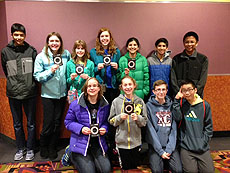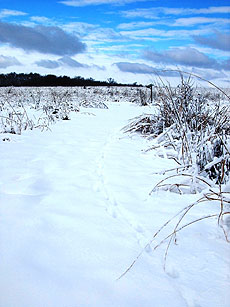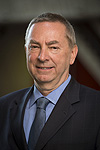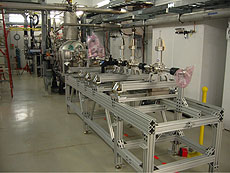|
Tuesday, March 18
- Breakfast: All-American breakfast
- Breakfast: bacon, egg and cheese bagel
- Grown-up grilled cheese
- Smart cuisine: pork loin with raspberry sauce
- Chicken pot pie
- Gourmet chicken salad croissant
- Kiwi pecan chicken salad
- Green pork chili
- Chef's choice soup
- Assorted pizza by the slice
Wilson Hall Cafe menu
|
|
Wednesday, March 19
Lunch
- Ham and gruyere crepes
- Cabbage salad
- Caramel macchiato cheesecake
Friday, March 21
Dinner
- Mixed greens with herb vinaigrette
- Fig and chili-glazed pork tenderloin
- Potato cakes
- Sauteed green beans
- Pecan rum cake
Chez Leon menu
Call x3524 to make your reservation.
|
|
Detection of waves in space buttresses landmark theory of big bang
From The New York Times, March 17, 2014
Editor's note: This article details a discovery by the BICEP collaboration of direct evidence for inflation, the accelerated expansion of the universe at its very beginnings. Fermilab scientists played major roles in developing the theory of inflation. In particular, Albert Stebbins and collaborators first proposed the method of observing patterns in the polarization, used by the BICEP experiment, of relic radiation to probe inflation in 1997. More about Fermilab's contribution will appear in tomorrow's issue.
CAMBRIDGE, Mass. — One night late in 1979, an itinerant young physicist named Alan Guth, with a new son and a year's appointment at Stanford, stayed up late with his notebook and equations, venturing far beyond the world of known physics.
He was trying to understand why there was no trace of some exotic particles that should have been created in the Big Bang. Instead he discovered what might have made the universe bang to begin with. A potential hitch in the presumed course of cosmic evolution could have infused space itself with a special energy that exerted a repulsive force, causing the universe to swell faster than the speed of light for a prodigiously violent instant.
Read more
|
Did you catch "Particle Fever" this weekend? Still showing in theaters this week
 |
Teacher Amy Truemper of Bednarcik Junior High School in Oswego brought this group of eighth graders to the Saturday showing of Particle Fever in Naperville. The students stayed after the film to ask incisive questions of the panel of Fermilab and Argonne scientists, moderated by Andre Salles. Photo courtesy Amy Truemper
|
"Particle Fever," the documentary about the Large Hadron Collider and the hunt for the Higgs boson, opened at the Music Box Theatre in Chicago and at the AMC Showplace 16 in Naperville on Friday. The film follows a group of scientists — a trio of theorists, some senior experimentalists and a first-year postdoctoral researcher — as they work to bring the LHC online. It culminates in the announcement of the discovery of the Higgs boson in July 2012.
Producer, star and theoretical physicist David Kaplan made an appearance at the Chicago theater this weekend, while the Naperville multiplex hosted a trio of Q&A sessions with physicists. Eight Fermilab scientists on the CMS experiment — Kevin Burkett, Richard Cavanaugh, Oliver Gutsche, Jim Hirschauer, Don Lincoln, Rafael Lopes de Sa, Verena Martinez Outschoorn and Elizabeth Sexton-Kennedy, as well as the Office of Communiction's Kurt Riesselmann — joined three Argonne scientists from the ATLAS experiment — Ben Auerbach, Taylor Childers and Tom LeCompte — for the sessions.
Questions ranged from the practical ("How many hours a day do you work?") to the abstract, with many of the most challenging coming from the younger members of the audience. Teacher Amy Truemper of Bednarcik Middle School in Oswego brought a group of eighth graders to Saturday's show, and the depth of their questions on the Higgs boson and the science of the LHC left the scientists in awe.
"Particle Fever" opened on 14 screens across the country. The small theater at the Naperville AMC was packed for each of the three Q&A screenings. Audiences were so taken with the film and intrigued by its subject matter that the question-and-answer sessions continued into the lobby of the theater, long after the house lights were brought up.
Particle Fever will run at both theaters through Thursday this week, and possibly later. Check the websites for the Music Box and the AMC Showplace 16 for showtimes and information.
—Andre Salles
|
The great white yonder
 |
| Fermilab Natural Areas volunteer Dave Giese took this photo of a blue-sky day on the Fermilab site. Photo: Dave Giese |
|
Summer hiring in 2014
This year's general summer hiring program will follow the same process as 2013, which was designed to democratize the program while preserving preference given to employee-referred candidates — particularly children of employees. Please note that intern programs do not follow this process.
The laboratory benefits from employing children of employees who already know and respect laboratory culture, and employees appreciate their children's opportunity to gain work experience at Fermilab.
The following guidelines to the summer hiring program will be applied in 2014:
- Employees may not request candidates on personnel requisitions.
- There will be no generic job postings. We will post each job specified with individual duties and knowledge, skills and abilities (KSAs).
- HR will evaluate candidates based on their responses to KSA-based screening questions.
- HR will not consider candidates who do not submit responses to screening questions.
- HR will refer only the top three candidates ranked for each job to the hiring manager.
- If there are no employee-referred candidates available or if no employee-referred candidates meet the qualifications, then outside candidates will be considered.
Hiring managers are encouraged to submit their summer personnel requisitions as soon as possible, no later than April 18. The summer employment announcement will be posted on the employment website upon receipt of an approved Summer Personnel Requisition form. The SPR form is available via the Service Desk website. Log in with your services user name and password. Under the "Request Things" heading, click "Summer Personnel Request." Please contact Jason Johnson at x5810 with questions regarding the summer hiring program.
Employees are encouraged to provide feedback on their experience with the new process.
|
|
The importance of solidarity
 |
Fermilab Director
Nigel Lockyer
|
This summer will mark a very important time for the field of U.S. particle physics. At the end of May, the Particle Physics Project Prioritization Panel will present our community's next long-term plan to the High-Energy Physics Advisory Panel, which advises DOE and NSF. This will culminate almost two years of very hard work on behalf of our community — beginning back in October 2012 with the kickoff of the Snowmass process.
While many eyes will be on P5's May presentation, the truly critical time will come in the weeks and months following HEPAP's acceptance of the plan and formal submission to the two funding agencies. It's during that time that our community must demonstrate unity of purpose as we communicate the plan to our field's many stakeholders. We must show solidarity both in describing the scientific excitement of our field and — perhaps most importantly at the current time — our willingness to set priorities and stick by them, no matter our personal research interests.
Why is this consensus so critical? It will make the difference between a U.S. community that receives the future funding it needs to thrive as a world leader in particle physics research and a community whose fortunes decline as other more unified fields flourish.
This need for consensus was brought into focus last week with the release of the President's Budget Request for the 2015 fiscal year, which starts October 1. While the budget for the DOE Office of Science is proposed for an overall 0.9 percent increase, the budget for the DOE Office of High Energy Physics is proposed for a 6.6 percent decrease. A strong long-term plan supported by a unified community is the only way to eliminate these instabilities in the federal budget for high-energy physics.
Key officials have been very clear in their statements about the need for unification. In a letter to the community delivered at the Snowmass on the Mississippi meeting in August, Secretary Moniz said it is "vital that the HEP community comes together to support the plan that results from the HEPAP deliberations." Acting Office of Science Director Patricia Dehmer reinforced this message last week, stating at HEPAP that a robust community-driven, community-backed plan is necessary to move our field forward.
We have an excellent P5 committee that has been working very hard and reaching out to as many members of the community as possible to gather input and perspectives. I look forward to aligning Fermilab with the P5 report and working with all of you this summer to make the best possible case to our stakeholders for a bright future for our community and for the international field of particle physics.
|
ASTA injector installation progress
 |
The Accelerator Division has installed the first injector girder in the ASTA accelerator at NML. Photo: Jerry Leibfritz, AD
|
The first injector girder was recently installed in the Advanced Superconducting Test Accelerator at NML. The ASTA injector consists of an electron gun, two SRF accelerating cavities and a 15-meter-long beamline. The injector accelerates the electron beam generated in the gun up to 50 MeV in the first leg of the ASTA accelerator, prior to sending it through the SRF cryomodules.
The injector beamline consists of three girders that contain the beamline elements — magnets, instrumentation and vacuum components — that are needed to transport the beam. All of the vacuum components must be particle-free and so must be assembled in a cleanroom.
Using the girder system allows the majority of the cleanroom work to be done outside of the accelerator enclosure. The final assembly is then installed as a completed unit. This process minimizes the amount of cleanroom work necessary in the enclosure, as well as the interruption to the ongoing commissioning of the rest of the ASTA accelerator.
Installation of the injector is expected to be complete this spring, followed by commissioning, which will involve sending beam from the gun to a beam absorber just upstream of the cryomodules.
—Jerry Leibfritz
|
Physicists, generals and CEOs agree: Ditch the PowerPoint
From All Tech Considered, March 16, 2014
About six months ago, a group of physicists in the U.S. working on the Large Hadron Collider addressed a problem they've been having for a while: Whenever they had meetings, everyone stuck to the prepared slides and couldn't really answer questions that weren't immediately relevant to what was on the screen.
The point of the forum is to start discussions, so the physicists banned PowerPoint — from then on, they could only use a board and a marker.
"The use of the PowerPoint slides was acting as a straitjacket to discussion," says Andrew Askew, an assistant professor of physics at Florida State University and one of the organizers of the forum at the Fermi National Accelerator Laboratory in Illinois.
He says it was as if "we removed the PowerPoint slide, and like a big glass barrier was removed between the speaker and the audience."
Read more
|
|